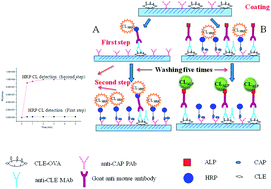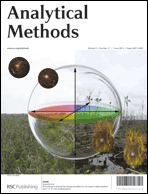Here are the top ten most accessed Analytical Methods articles from October to December 2013.
Fluorescence spectroscopy and multi-way techniques. PARAFAC
Kathleen R. Murphy, Colin A. Stedmon, Daniel Graeber and Rasmus Bro
Anal. Methods, 2013,5, 6557-6566
DOI: 10.1039/C3AY41160E, Tutorial Review
Photocatalytic reduction of CO2: a brief review on product analysis and systematic methods
Jindui Hong, Wei Zhang, Jia Ren and Rong Xu
Anal. Methods, 2013,5, 1086-1097
DOI: 10.1039/C2AY26270C, Minireview
Fluorescent probes for selective determination of trace level Al3+: recent developments and future prospects
Sudipta Das, Mili Dutta and Debasis Das
Anal. Methods, 2013,5, 6262-6285
DOI: 10.1039/C3AY40982A, Minireview
Nanoparticles: a global vision. Characterization, separation, and quantification methods. Potential environmental and health impact
Ana López-Serrano, Riansares Muñoz Olivas, Jon Sanz Landaluze and Carmen Cámara
Anal. Methods, 2014,6, 38-56
DOI: 10.1039/C3AY40517F, Critical Review
Detection of apoptosis: A review of conventional and novel techniques
Michelle M. Martinez, Randall D. Reif and Dimitri Pappas
Anal. Methods, 2010,2, 996-1004
DOI: 10.1039/C0AY00247J, Critical Review
Let there be chip—towards rapid prototyping of microfluidic devices: one-step manufacturing processes
Ansgar Waldbaur, Holger Rapp, Kerstin Länge and Bastian E. Rapp
Anal. Methods, 2011,3, 2681-2716
DOI: 10.1039/C1AY05253E, Critical Review
Electrochemical impedance spectroscopy: an overview of bioanalytical applications
Edward P. Randviir and Craig E. Banks
Anal. Methods, 2013,5, 1098-1115
DOI: 10.1039/C3AY26476A, Critical Review
Rhodamine and BODIPY chemodosimeters and chemosensors for the detection of Hg2+, based on fluorescence enhancement effects
M. J. Culzoni, A. Muñoz de la Peña, A. Machuca, H. C. Goicoechea and R. Babiano
Anal. Methods, 2013,5, 30-49
DOI: 10.1039/C2AY25769F, Critical Review
Application of Raman spectroscopy for the differentiation of lipstick traces
Fatma Salahioglu, Michael J. Went and Stuart J. Gibson
Anal. Methods, 2013,5, 5392-5401
DOI: 10.1039/C3AY41274A, Paper
The Folin–Ciocalteu assay revisited: improvement of its specificity for total phenolic content determination
Juan Carlos Sánchez-Rangel, Jorge Benavides, J. Basilio Heredia, Luis Cisneros-Zevallos and Daniel A. Jacobo-Velázquez
Anal. Methods, 2013,5, 5990-5999
DOI: 10.1039/C3AY41125G, Paper
If you have any comments or thoughts on any of these articles, we welcome you to write these in the comment box below.
Do you fancy submitting an article to Analytical Methods? Why not submit to us here today or alternatively email us with your suggestions!

















